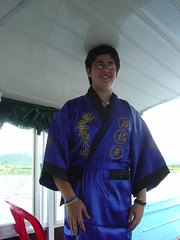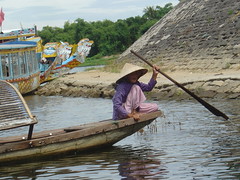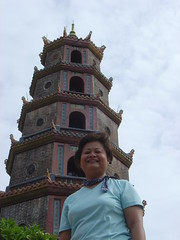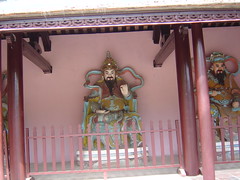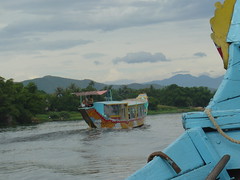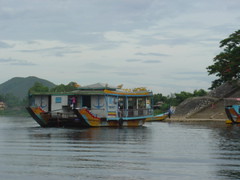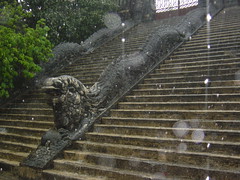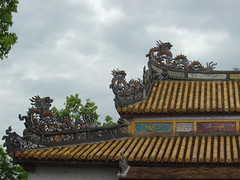One trend we didn't quite expect on our trip to Vietnam was the tendancy for tour guides to bring out the gift selection in the middle of the trip. I think that because the tours themselves are so inexpensive, the boat operators rely on the supplemental sales of drinks and merchandise to make a profit. Several times when we wanted to buy drinks at the various stops, our guide suggested we wait until we get back on the boat. They always had a good selection of canned and bottled beverages on board, so it wasn't a problem giving them our business.
Inevitably, there was also some other type of merchandise available as well. We first encountered this on our boat ride in Halong Bay when as we were returning to port, the hostess on the boat brought out a large assortment of pearl jewelry. We ended up buying several items as gifts.
On the Perfume River, during our boat ride from Hue, we were presented with all varities of silk robes and and locally manufactured name brand clothing The prices were very reasonable and we did end up getting a few items. My son is modeling the reversible silk robe that he selected.
In the Mekong Delta and around Saigon, the tour operators expected tips instead. Overall, I prefer the clothing and jewelry as tour operator revenue enhancement. At least the purchases qualify as souvenirs.
Tuesday, October 25, 2005
Wednesday, October 19, 2005
Begging By Boat
As would be expected in a developing nation like Vietnam, beggars would be found everywhere tourists would be. This very old lady had a small, small boat that she had rowed up to the dock at the Thien Mu Pagoda in Hue. From here she could solicit all the tourists arriving on the brightly colored dragon boats like the one in the background.
Beggars in Vietnam seemed more genuinely destitute than the equivalent homeless street person in the United States. They tended to be very old or suffered from some sort of severe disfigurement. They were also more persistent than American panhandlers.
Overall, the number of beggars we encountered was smaller than we had anticipated, but that didn't make their presence any less heart wrenching or pity inducing.
Beggars in Vietnam seemed more genuinely destitute than the equivalent homeless street person in the United States. They tended to be very old or suffered from some sort of severe disfigurement. They were also more persistent than American panhandlers.
Overall, the number of beggars we encountered was smaller than we had anticipated, but that didn't make their presence any less heart wrenching or pity inducing.
Sunday, October 16, 2005
Thien Mu Pagoda
The first stop on our river boat tour from Hue was the Thien Mu Pagoda, which is also known as the Linh Mu Pagoda. Boats pull right up to a dock at the river bank and the pagoda is at the top of a set of steps overlooking the river. The pagoda was first built in 1601 and the current version dates back to 1844. The pagoda is seven stories high and each level has an altar to a different Buddha.
The temple is a working Buddhist monastery and school. We passed a school in session in one of the back buildings. Children in the traditional brown robes were studying and chanting the teachings of Buddha. The grounds also have a wonderful collection of small gardens and fruit trees.
In addition to the pagoda, the temple includes a large bell that was cast in 1710, the usual collection of Buddha statues and a group of carved and brightly painted statues that guard the temple area.
After the division of the country when the French left, Buddhists were persecuted under the Catholic dominated South Vietnamese government. Buddhism being a very pacifist religion, a form of protest was for monks to douse themselves with gasoline and immolate themselves in a public place as protest.
The first monk to to this, Thich Quang Du, was from this temple. The temple still owns and displays the car that is in the background of a very famous picture showing the protest. The photo can be seen in this article.
The temple is a working Buddhist monastery and school. We passed a school in session in one of the back buildings. Children in the traditional brown robes were studying and chanting the teachings of Buddha. The grounds also have a wonderful collection of small gardens and fruit trees.
In addition to the pagoda, the temple includes a large bell that was cast in 1710, the usual collection of Buddha statues and a group of carved and brightly painted statues that guard the temple area.
After the division of the country when the French left, Buddhists were persecuted under the Catholic dominated South Vietnamese government. Buddhism being a very pacifist religion, a form of protest was for monks to douse themselves with gasoline and immolate themselves in a public place as protest.
The first monk to to this, Thich Quang Du, was from this temple. The temple still owns and displays the car that is in the background of a very famous picture showing the protest. The photo can be seen in this article.
Wednesday, October 12, 2005
River Dredging
Dredging river bottoms for sand is a major cottage industry along rivers in Vietnam. These boats are on the Perfume River just upriver from Hue. The river dredging operation relies on manual labor. We passed the boats too fast to completely digest the full operation, but this video shows a quick glimpse. It seems to involve a couple of people at a paddle wheel sort of spindle and a long pole that gets raised and dropped.
Each river boat is a family enterprise with everyone on the boat helping out in the operation. Sand is then barged downriver to riverside concrete factories where concrete blocks are made and sold to the fast growing construction business.
Powered by Castpost
Each river boat is a family enterprise with everyone on the boat helping out in the operation. Sand is then barged downriver to riverside concrete factories where concrete blocks are made and sold to the fast growing construction business.
Powered by Castpost
Sunday, October 09, 2005
Sand Boats
Sand boats ply the waterways up and down the Perfume River in Vietnam. The sand is used to make concrete for construction. These boats are powered by small motors.
This video shows an empty boat traveling upstream which passes two fully loaded sand boats headed downstream. The full sand boats are loaded up until they barely float under the weight of the sand. Most boats have at least one crew member constantly bailing water out that overflows into the boat.
Powered by Castpost
This video shows an empty boat traveling upstream which passes two fully loaded sand boats headed downstream. The full sand boats are loaded up until they barely float under the weight of the sand. Most boats have at least one crew member constantly bailing water out that overflows into the boat.
Powered by Castpost
Thursday, October 06, 2005
Up The Perfume River
Hue is located on the Perfume River, which is one of the six major rivers in Vietnam. Hue is actually fairly inland and near the foot of a series of mountains. The older fortress Imperial City part of Hue sits on one side of the river and the newer commercial district is on the other.
The river is a major economic factor for the area with boats and barges forming a steady stream of traffic. River boats are wide bottomed and shallow with a pointed raised bow and a small cabin near the stern. Many families live on their boats and either fish or dredge river sand for a living.
Tourist excursions up the river a very popular way too see the attractions on or near the river. The tourist boats are standard river boats that have been painted a light blue and decorated like a dragon. They have about six rows of seats with a canopy or awning for protection from the sun. Larger tourist boats are double hulled catamaran style.
The slight breeze as the boat goes up river helps disperse the stifling humidity. But even with the draft, Hue was even warmer and muggier than Hanoi.
The river is a major economic factor for the area with boats and barges forming a steady stream of traffic. River boats are wide bottomed and shallow with a pointed raised bow and a small cabin near the stern. Many families live on their boats and either fish or dredge river sand for a living.
Tourist excursions up the river a very popular way too see the attractions on or near the river. The tourist boats are standard river boats that have been painted a light blue and decorated like a dragon. They have about six rows of seats with a canopy or awning for protection from the sun. Larger tourist boats are double hulled catamaran style.
The slight breeze as the boat goes up river helps disperse the stifling humidity. But even with the draft, Hue was even warmer and muggier than Hanoi.
Saturday, October 01, 2005
Dragons Everywhere
In Hue, and in Vietnam in general, dragons are a very common decoration on the palaces, temples, and tombs. The dragon is one of the four sacred animals of Vietnam. The others being the turtle, the phoenix and either the unicorn or the lion, depending on your source. Dragons are often carved into the ornamentation in ways that make the carving part of the building or structure.
The first picture shows the largest dragon in Vietnam. His body and tail go all the way up this very grand set of steps. This dragon is one on of four or five dragons that are stair railings going up to the tomb of Khai Dinh. This tomb is set on the side of a mountain and the stairs are very steep.
The photo is streaked by rain from the torrential downpour that started while we were at the top of the tomb. The fast flowing rain and worn steps made descending back to the tour van very hazardous.
The second picture is a close up of the roof of the Imperial City. There are a total of nine dragons on the roof of the building. Nine is a sacred number in Vietnam.
Dragons are on nearly all of the buildings in the Forbidden City. If you look at the full 3 megapixel size photo (warning to dial up users: link is 1.5 MB) that was used in the post about the Forbidden City you can see the dragons all along the roof of the entrance pavillion as well.
The first picture shows the largest dragon in Vietnam. His body and tail go all the way up this very grand set of steps. This dragon is one on of four or five dragons that are stair railings going up to the tomb of Khai Dinh. This tomb is set on the side of a mountain and the stairs are very steep.
The photo is streaked by rain from the torrential downpour that started while we were at the top of the tomb. The fast flowing rain and worn steps made descending back to the tour van very hazardous.
The second picture is a close up of the roof of the Imperial City. There are a total of nine dragons on the roof of the building. Nine is a sacred number in Vietnam.
Dragons are on nearly all of the buildings in the Forbidden City. If you look at the full 3 megapixel size photo (warning to dial up users: link is 1.5 MB) that was used in the post about the Forbidden City you can see the dragons all along the roof of the entrance pavillion as well.
Subscribe to:
Posts (Atom)
